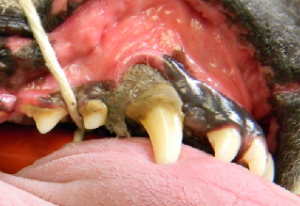Have you ever broken a tooth? You probably ran straight to the phone and called your dentist’s emergency line to get yourself an appointment to have it fixed right away. Ever had a cavity? That was probably pretty uncomfortable, too, wasn’t it? What about something as simple as a popcorn kernel or strawberry seed stuck between your teeth? Even that probably drove you crazy until you managed to get rid of it. We all know that dental disease in humans is incredibly painful, but how do we know that the same is true in our pets? Because even though the shape of our pets’ teeth is very different from ours, the underlying anatomy of the tooth is actually quite similar. While the white enamel that covers the outside of your and your pets’ teeth is the hardest substance in the body, underneath that outer protective layer is a substance called dentin, which is crammed full of microscopic tubules with nerve endings in each one. At the center of all of that nerve-rich dentin in each tooth is the root canal containing the main blood and nerve supply of the tooth, which can become exposed to the outside when teeth break or decay. Nerve-rich gum tissue surrounding each tooth and tooth roots that don’t have any protective enamel covering in the first place all combine to provide the potential for a lot of pain in the mouth when teeth or their surrounding tissues become diseased. Part of the problem, however, is that our dogs and cats can’t tell us when their teeth hurt, and will often continue to eat or carry toys around despite severe oral pain.
In addition to the severe discomfort that comes along with dental disease, diseases in the mouth carry a huge risk of infection for organs throughout the body, not just in the mouth itself. Remember those tubules throughout the dentin of each tooth that house all of those nerve endings? If the protective enamel that covers the dentin and its tubules is destroyed by a fracture or tooth decay, the exposed dentinal tubules provide a perfect route for bacteria to enter the tooth and make their way into the root canal. They can then set up shop right there, causing painful infections in the bone surrounding the root of the tooth, or they can enter the bloodstream and cause infections in vital organs such as the heart and kidneys. Even without any broken teeth or obvious damage to enamel, gingivitis (inflammation of the gums, which is often caused by bacterial buildup on the teeth) can lead to periodontal disease, which involves more severe infection and destruction of the deep tissues that support healthy teeth – the gums themselves, the bones of the upper and lower jaws, and the ligaments that hold the teeth in place.
The good news is that dental disease can be easily treated if caught early in the course of gingivitis, or better yet, prevented before tartar builds up and gingivitis develops at all. Prevention of dental disease is your job to start at home. You know that feeling when you run your tongue across your teeth in the morning and it kind of feels like your teeth have socks on? That’s plaque, a bacterial film that is the precursor to that solid calcified tartar that covers many of our dogs’ and cats’ teeth. Unfortunately for teeth, plaque starts to accumulate almost immediately after tooth brushing, which means that daily brushing of our pets’ teeth is the most effective way to help prevent plaque from being around long enough to solidify into tartar in the first place. In addition to brushing (always with a pet toothpaste, not a human toothpaste, many of which are toxic to dogs and cats), look for commercially available products such as treats and oral sprays that have earned the seal of the Veterinary Oral Health Council (VOHC) because of their proven efficacy at helping to prevent plaque and tartar; a list of these products is available at the VOHC website, www.vohc.org. When looking for appropriate chew toys for your dog, never offer something that is harder than the teeth themselves or we run the risk of fractured teeth; if you can’t bend it by hand or indent it with your finger nails, it’s best to avoid letting your dog chew on it.
We can’t stress enough the importance of home care when it comes to oral health, but even daily brushing of our pets teeth and excellent home care do not eliminate the need for routine comprehensive oral exams and dental assessments and cleanings by a veterinarian, the same way daily brushing of our own teeth does not eliminate the need to visit the dentist regularly.
Remember, bad breath, even in a dog or cat, is NOT normal and can be a sign of serious dental disease. If you cringe away from the odor every time Fluffy comes to give you a kiss or if you lift up her lip and see red, angry looking gums or visible tartar on her teeth, set up an appointment so that we can evaluate the degree of dental disease present and work together to formulate a plan for addressing the issue. The early stages of gingivitis can be reversed with thorough evaluation and tooth scaling performed with your pet under anesthesia, while more advanced periodontal disease often requires oral surgery to extract diseased, dead, or broken teeth in order to get your pet’s health back up to par.
Please do not hesitate to call our office with any questions about your pet’s oral health, or if you’d like to schedule an appointment to have your pet’s teeth (and whole body!) evaluated by one of our veterinarians.
Dr. Clifford


